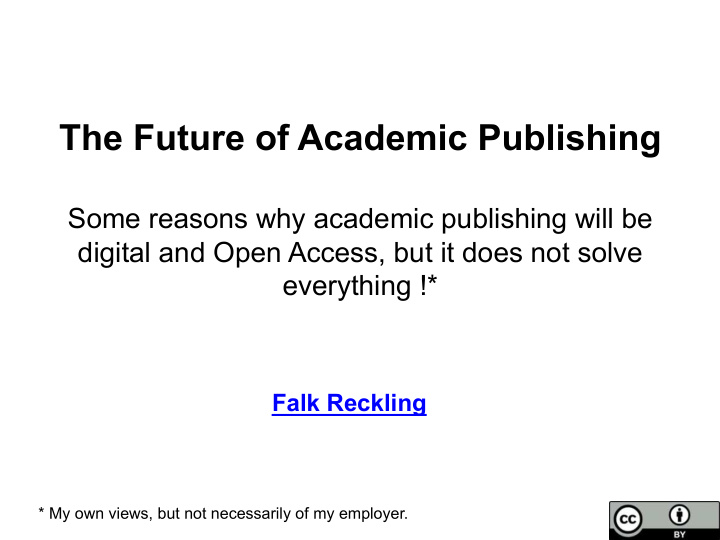



The Future of Academic Publishing Some reasons why academic publishing will be digital and Open Access, but it does not solve everything !* Falk Reckling * My own views, but not necessarily of my employer.
1. Digitisation § Since ~ 20 years almost all new scientific publications are digital. § Digitisation is the only way to preserve old materials to a large extent.
2. Advanced Devices The quality of technical devices for perceiving and disseminating publications has significantly increased.
3. Generation Change The generation of the digital born natives comes to power in research. And this generation does not only have new technical skills but different approaches to reading and sharing information.
4. Multimedia Enrichment Digital publishing allows the integration of different muliti- media formats and the visualisation of research. Bosman, J , Kramer, B (2016): Swiss army knives of scholarly communica?on - ResearchGate, Academia, Mendeley and others. Figshare, Retrieved: 15 15, Apr 06, 2017 (GMT)
5. Reproducibility § Ulrich Dirnagl: „Wir produzieren zu viel Forschungsmüll.“ § Reproducibility of research results will be one of the greatest challenges in the upcoming years, and the essential precondition is „openness“.
6. Information Filtering § The explosion of research information requires intelligent search, filtering and evaluation tools. § It is highly problematic that some companies offer those tools for their own products behind paywalls and the raw data of the tools are mostly closed.
7. Impact Expansion Open Access helps to extend the impact of research results.
8. Economic Efficiency * Open Access Market Subscrip9on Market (still) low high § 2015: the 10 biggest OA § 2013: the 4 biggest publishers have Market publishers only publishes 16% publish > 50% of all articles Concentra9on of all articles low high Market Entrance 7 of 10 biggest OA publishers 8 of 10 biggest publishers were § § Barriers were founded after 1994 founded before 1900 high low most important innovations in big publishers are concentrating on § § Innova9ons academic publishing are OA growth, acquisitions and business driven models (relatively) high low Price sensivity § prices are more transparent § prices are intransparent (still) moderat very high Pricing Ø € 1.300 per paper • Ø € 3.800 per paper § *Quelle: JISC (2015): Academic journal markets, their limita?ons, and the consequences for a transi?on to open access
9. Political Attention OA finds more and more support from high politics. " The results have to be free and open to anyone from the minute they are published“ Joe Biden, former US Vice President “ … . open access makes complete sense. It generates income, raises excellence and integrity, and involves the public in what they pay for.” Carlos Moedas, EU Commissioner
10. Piracy, the disruptive innovation? John Bohannon: Who's downloading pirated papers? Everyone, Science, Apr. 28, 2016, DOI: 10.1126/science.aaf5664
It‘s the economy, stupid ! “ … the core problem is the persistence of a friction- based business model in a network environment that is essentially frictionless. Human factors research tells us that when users keep making the same mistake, it isn't a mistake - it's the system that needs to change. Flip the business model to open access, and the Sci-Hub problem goes away - it becomes unnecessary on the one hand and legitimate on the other.“* *Ivy Anderson: http://www.sciencemag.org/news/2016/04/whos-downloading-pirated-papers-everyone#comment-2648543579
But Open Access does not solve everything Percentage of articles in Web of Science by publishers from 1973 to 2013 Larivière et al 2015 13
Market Concentration, with or without OA If the market trend of the last years continues, then in the next ten years two or three commercial giants will exploit not only publications but the entire academic workflow.
Take over of the entire academic workflow Source: Kramer/Bosman 2015 15
Challenge I: Changing „Big Deals“ ! 1) short-term ð transformation of „big deals“ with publishers from subscription to OA – see initiative OA2020 by the Max Planck Society 2) mid-term ð making publication cost transparent and organising monitoring - see initiative OpenAPC 3) long-term ð paying publishers not for bundles anymore but for defined services per publication – see Science Europe principles
Challenge II: Functional Market § more market competition by across the boarder funding for transition and new OA models § a non-commerical Open Access infrastructure ð see Knowledge Exchange
But it needs … (1) Reputation (2) Sustainable Funding (3) Critical Mass
Thank you for your attention ! Open Access Network Austria (OANA): http://www.oana.at/ Open Access Empfehlungen: http://dx.doi.org/10.5281/zenodo.33178 FWF Twitter Open Access: @FWFOpenaccess
Recommend
More recommend